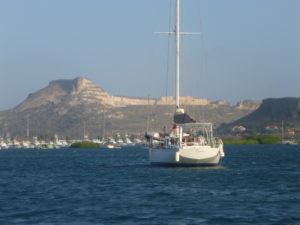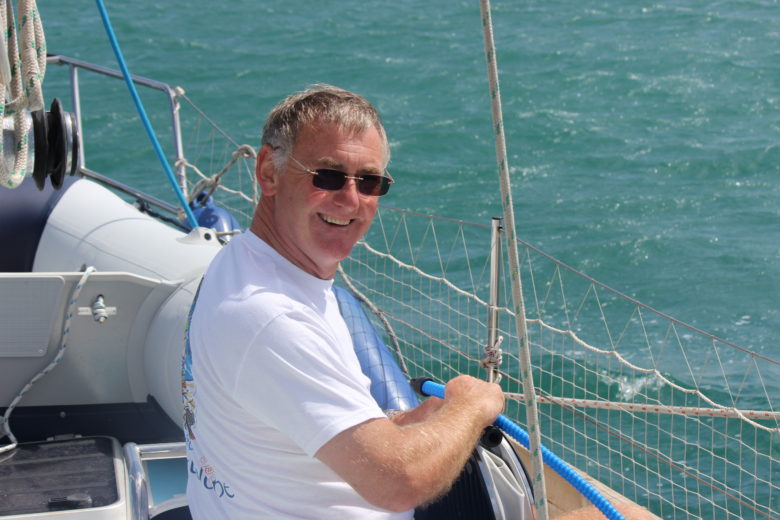14:05.25N 65:11.92W.
Half way to Curacao across the Caribbean Sea.
The pelicans had already started crash diving for their breakfasts in the marina when we brought our stern lines aboard and Zoonie motored gently forward, with a short halt for Rob to release our bowline from the buoy. Then I gave Zoonie a burst ahead with the wheel full to port to turn her in the short distance we had before we reached the mooring buoys opposite. She has a bow thruster but I can be purist.
We had breakfast and showers alongside the fuel jetty, awaiting the marinero and then we were off, sailing past the verdant slopes of lovely Guadeloupe towards the gap between her and the greening of Les Saint Iles. We were leaving behind us our friend the North Atlantic and entering the Caribbean Sea, with both a fine wind and current sending us into new waters for the three of us.
That night the wind died and tired of hearing the slatting of the sails we resorted to motoring and wondered where the forecasted fair wind had gone.
Our second day was hot and airless. The highlight, or low point depending on how you look at it, was seeing and hearing a tug on the daisy chain fishing lure trailing behind and Rob bringing it in to find one plastic squid of the five left and hefty teeth marks. A big fish had taken the rest from a sideways grab so hopefully the hook will have been released into the sea and not caught in the fish. (Photos of tooth marks to follow.) We were both glad we hadn’t brought it on board, with teeth like that.
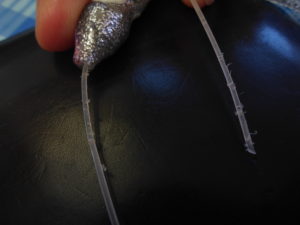
We tried the diva in the afternoon but there was not even enough wind to fill her ample lungs.
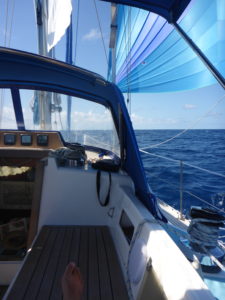
“Please no lightening to take out our electrics,” I whispered as I sat on watch that night, watching a massive squall approach. But it was kind and just delivered enough rain to wash the windows and cool the air. At first light we set the sails to catch the generous 12 knots it left us in its wake but sadly that too soon faded.
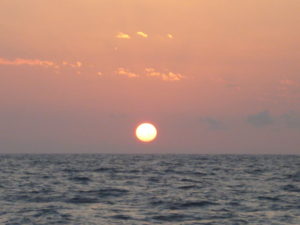
We keep one big window open to bring in some air to the saloon and have to remember to close it if it rains. This morning it was blissful from daylight before the sun rose and afterwards for a few more minutes before it shone and brought great heat. It is 38’ in the saloon, but bearable with a little passing air, and we are luxuriating in cool showers. Getting ready for the night watch these days doesn’t take long, just on with the vest top and shorts and we’re ready. Day time attire is: well best not go there.
Zoonie is now sailing again with the help of an approaching cloud mass giving 13 – 16 knots, let’s hope it lasts!
12:04.83N 68:51.73W Turbulent Teens and Spanish Bay, Curacao
Arrival at Curacao. Saturday 6th February 2016.
As I sit here in the safe anchorage of Spanish Bay Curacao, Zoonie is affected only by the wind, which although it is fresh at around 20 knots, just rocks her gently from side to side as she is secure with the anchor stuck nicely in deep mud, mud, glorious mud and Henry keeps whirring away producing his trickle charge to the batteries.
Outside the bay, however, is a different story. Along the north coast of Venezuela, which is itself fairly straight, a band of water 150 miles or so wide, picks up the trade wind from the Atlantic and does exactly the same as its bigger counter wind cousin down under in the Southern Ocean, it builds freely without obstruction.
Coming as we did early yesterday morning from the mild mid Caribbean Sea and a final day and a half of fine sailing, down the east coast of Bonaire it was then like stepping onto a fast moving conveyor belt speeding along immediately north of the South American landmass. At latitude 12’ to 13’, The Turbulent Teens.
I was sitting in the cockpit at first light quietly solving a Sudoku, when I looked up in alarm to see Zoonie, rig polled out each side and rigid, plunging down into a mighty deep trough of dark grey smoothly curved water. She lifted willingly again but “Where on earth (or sea) did that come from?” I thought.
Turning around, gulp, there’s plenty more of that to come as the rollers came plunging towards us. I threw my tablet onto the settee below and dived for the helm, knowing that Henry would not be able to hold Zoonie if she was flicked around and risked broaching side on to an oncoming wall of water.
Henry did well and I only had to intervene a couple of times as we shot along south of Bonaire towards Klien Curacao island, which I presumed meant Curacao’s child.
The chart showed wrecks on the small islands and rocky areas around and the child was no different, the well-rounded belly of a sailing yacht and a beached upright steamer just a few metres away sent a warning like no other of the need to be alert and very careful.
We were lucky to have detailed accounts of the approaches from other yachtsmen, written in an informal and downloadable guide and it was invaluable. The chart showed few land details apart from the sandstone quarry and wooden structures that stood over the old phosphate mines.
The entrance to Spanish Bay is not easy to see but between the guide, chart, and chartplotter we guessed it was to the left of a range of new terracotta roofs which turned out to be a luxury golf resort of Punta Barbara. How appropriate. Barbara closes Punta Barbara.
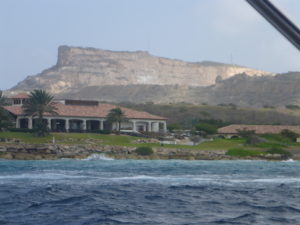
Our waypoint half a mile off the entrance gave us time to duck out if we needed to. The chart showed it as a scoop, ready to take us in as we were coming from the east but as we got nearer we could see the rocks on the left and sandbar on the right, with people sitting up on the beach a few metres away. Reading about this before from the guide prepared us but also filled us with apprehension.
Our safe gap was about 30 feet wide and we still had up to 20 knots of wind trying to push us across towards the rocks. Rob countered this effect with careful steering and set Zoonie on a nice course right through the middle, “Please don’t let there be another vessel coming out.”

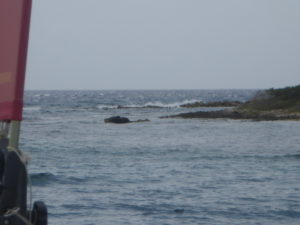
Well there were two Florida style fishing boats with their high seating structure and long rods bending in the wind, but they found their way around us and in seconds those big waves were behind us and only flat, beautifully turquoise water lay ahead.
The skyline is made up of massive faulted and golden rock structures rising up a long slope to stop with a vertical wall and lower gently curved hills covered in scrubby looking undergrowth. On each bend in the channel inwards we had to deviate to avoid shallows visible in the paler colour of the water. The guiding white buoys shown on the chart were not there so the movement of local vessels was useful and we sometimes followed the wake of one that had just passed.
Luxury homes with their own waterfronts started to appear and as we entered the bay proper they became the norm all around the shore of this hand shaped bay.
The permitted anchorages are clearly marked on the guide and chart and we had read they would be very crowded, but then the information we had was at least 6 years old and predated the negative effect of the global recession on yachting. “There’s something in the water over there have a look through the bins Barb,”
“Rocks, babe, the clear water seems to be on the left.” Once clear through there we approached anchorage “A” and ahead of us was a perfect big gap with interesting yachts anchored around it. Rob went to the foredeck to get the anchor ready and as I circled Zoonie a Dutchman on his classic Bota with its upwards curving bow, waved us to the area ahead of him where maybe a yacht had left that morning.
So here we are, just over 500 miles from Guadeloupe having used the same amount of fuel in five days as we used in eighteen across the Atlantic. We did the same on arrival as we had on arrival in Tenerife, had a wind-down spell and meal and then a long snooze before a social evening together and good night’s sleep. We didn’t need that in Guadeloupe as we were so into the sea routine after 18 days we had had sufficient rest.
Being at anchor means Zoonie is constantly facing the wind so with the big windows at the front of the saloon open we have a lovely constant draft blowing through, just have to remember to put towels over the settees in case of rain at night.
